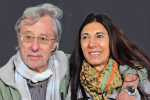 The Buddha’s First Noble Truth promises that you will meet up with plenty of problems in life.
The Buddha’s First Noble Truth promises that you will meet up with plenty of problems in life.
You’ll grow old and get sick – you won’t like that. You will lose things you love and be forced to deal with people you loathe. You won’t like that either. But we are an integral part of a universe that works that way, so whether we like it or not, surely it is wise not to deny or avoid this obvious fact but learn to engage it uncompromisingly, as it comes, with all its disappointments and hurts, beauty and loveliness, with compassion, joy and moral integrity.
When we look at a Buddha image we see a still figure, sitting in quiet repose in meditation, with his eyes partly closed as if half asleep and a serene smile on this face – distant, it seems, from the mayhem of the world around him. Yet, paradoxically, that smile is synonymous with having come face to face with suffering and having overcome it. This is the very ground of his philosophy: his First Ennobling Truth.
I had a first hand experience of meeting suffering with that smile when I modelled the big Buddha in the BRC garden.
As some of you know, I was let down by a sculptor friend of mine who had promised to fashion the face of the Buddha, never having done anything like that myself, especially on such a huge scale.
I had sculpted the rest of the body, but the face daunted me. For some time it was just a lump of concrete. I had started to shape the eyes, the ears and nose, but not those smiling lips which, to me, represent the very essence of the Buddha’s teachings.
After some procrastination, feeling let down by my sculptor friend, the day arrived when I could no longer delay modelling that mysterious smile.
The Mona Lisa’s smile has a similar mystique. Leonardo da Vinci worked on the Giaconda portrait for something like 8 years. Right up to his death he claimed that he had still not quite caught that enigmatic smile he was seeking. Some people say he had fallen in love with his sitter. Maybe those lips concealed a secret the two were sharing. Whatever - Leonardo refused to part with the picture, saying it was not finished.
The smiles of the Buddha and the Mona Lisa are the most famous in the history of art.
Who was I to tackle such an enigma?
One day I decided it was time to do it – starting the following morning. It was mid winter. I was woken in the early morning to be told that we had run out of water - which at that time was pumped up from the dam, far down in the valley. I knew what this meant. I had to walk down into the valley with a 3 meter-long steel pipe over my left shoulder and a “bobbejaan” in my right hand. A bobbejaan (“baboon”) is a monster of a shifting spanner, a wrench of solid steel, almost a meter long. It weighed as much as the pipe. The intention was to lengthen the pipe in the dam so that it could reach further down into the dam and collect water from a shallow patch of very muddy water. I wasn’t fussy in those days about what I drank. I had got used to that in India.
I was by myself. It was bone-crushingly cold so early in the morning. A chill blanket of frost and mist hung menacingly across the surface of the water. My body was not prepared for this. As I was trying to unscrew the pipe socket with the bobbejaan, my back gave in with an ominous crack. I doubled over with paralyzing pain, crouching down on my hands and knees, unable to move. Now what?
I assumed that someone may find me there when I didn’t turn up for breakfast. Or so I hoped. But would I last that long? Slowly freezing to death? Those were the days before cell phones.
Eventually I made it to my cottage, crawling up the hill on all fours, before anyone else had woken up. I plunged into a hot bath and kept the hot water running until it had drained the geyser. Lying in bed, I thought about that Buddha smile. Obviously, it had to wait until I had recovered. But I suddenly decided otherwise. Maybe deliriously, I asked to be hoisted up the scaffold around the Buddha and strapped to the scaffolding for extra support for my back. There I sat face to face with that enormous head that had no mouth. It would have to be about the size of an outstretched hand. I had a bucket of mortar and a spatula and proceeded to sculpt the lips.
It struck me then that this was quite symbolic: to catch the serene Buddha smile whilst experiencing intense pain and, maybe, with some suffering added for good measure.
The Buddha, of course, drew a distinction between pain and suffering. Pain is principally physical; suffering is largely psychological. The two are interconnected. But if you add the one to the other, without distinguishing between the two, your hurt becomes unbearable.
Better deal sensibly with your hurts. Don’t add your own stuff to it. Get on with your life.
Louis

